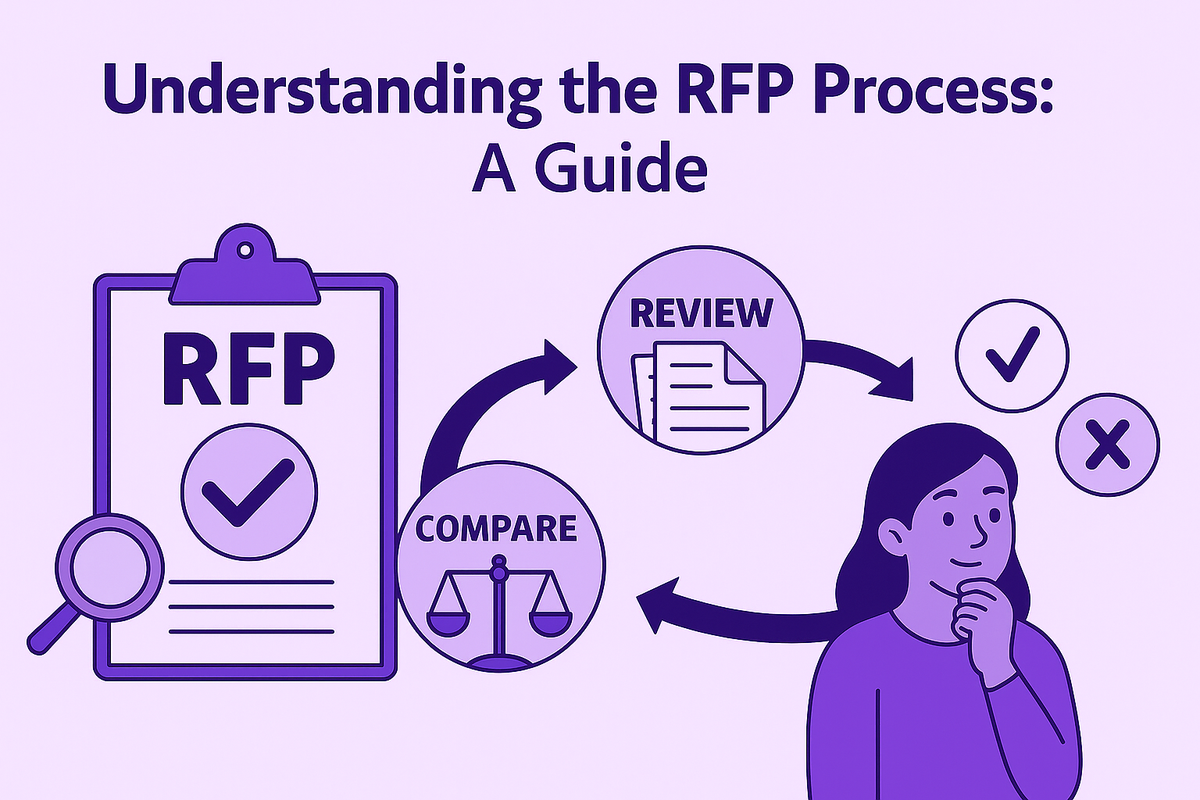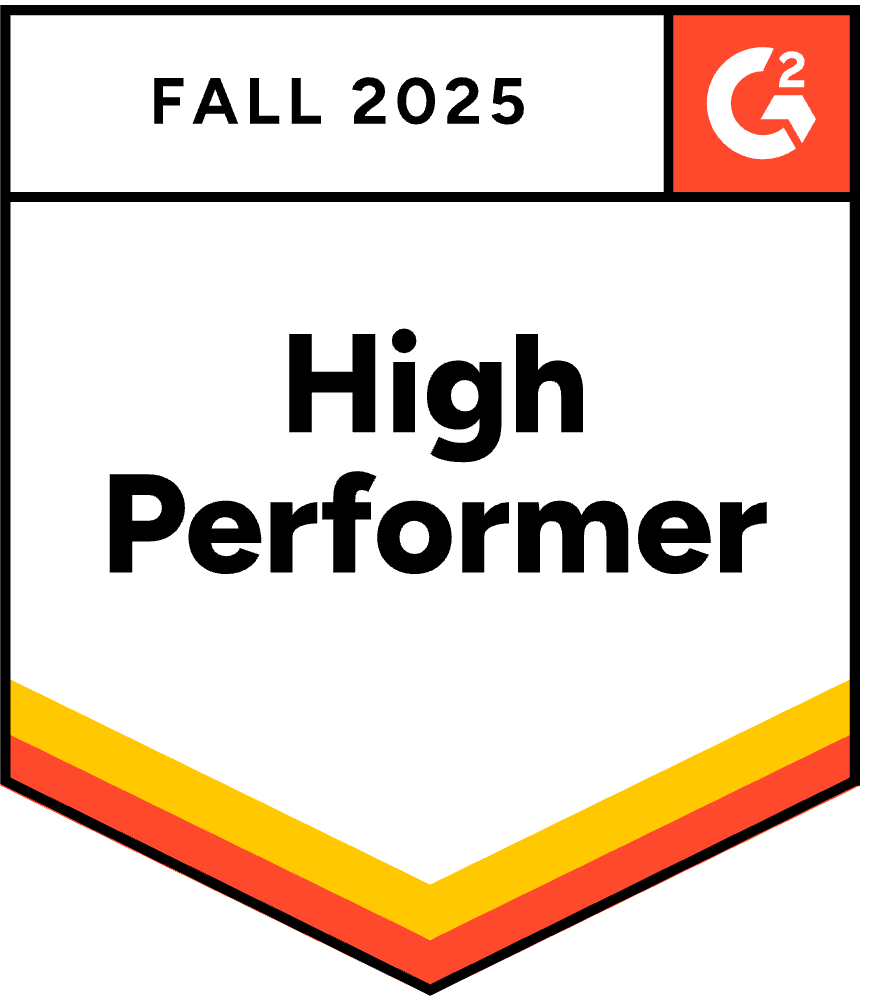8 RFP Process Best Practices for Winning More Bids
July 16, 2025
By
Evie Secilmis

How to Improve Your RFP Process
Let’s be honest—the Request for Proposal (RFP) process can feel clunky, time-consuming, and more complicated than it needs to be. If you're tired of chasing approvals and sifting through inconsistent proposals, you're not alone. But it doesn't have to be that way. By following a few rfp process best practices, you can achieve significant rfp process improvement. This guide shares actionable tips on how to improve your rfp process, helping you cut down on inefficiencies and make the whole experience smoother for everyone involved.
Before diving into improvements, it’s vital to understand what the RFP process entails. An RFP is a document that outlines the requirements and criteria for a project or service that a company wishes to procure. Vendors respond to the RFP with proposals detailing how they would meet the requirements, along with cost estimates.
The RFP process typically includes the following steps:
- Identifying Needs: Clearly define what you need from the vendor.
- Drafting the RFP: Create a comprehensive document that includes project scope, goals, and selection criteria.
- Distributing the RFP: Share the document with potential vendors.
First Things First: Understanding the RFP Landscape
Before you can start improving your RFP process, it’s essential to get a firm grip on why they exist in the first place. RFPs aren't just administrative hurdles; they serve specific, strategic purposes for the organizations issuing them. Taking the time to understand their goals helps you see the process from the buyer's perspective, allowing you to tailor your responses more effectively. When you know what they’re trying to achieve, you can show them exactly how you’re the right partner to help them get there. This shift in perspective is the first step toward creating proposals that don't just answer questions, but actually win deals.
Why Organizations Use RFPs
At its core, an RFP is a tool for managing risk and optimizing value. When a company is about to make a significant investment in a new product or service, it needs a structured way to evaluate potential partners. This formal process helps them compare vendors on a level playing field, ensuring they make an informed decision based on clear criteria rather than just a gut feeling. It’s all about bringing order to a complex decision and giving stakeholders the confidence to sign off. For your sales team, recognizing this helps frame your proposal not just as a sales document, but as a direct solution to the buyer's core challenge: making the best possible choice.
For Complex Projects
When a project is intricate and demands specialized skills, a simple price quote just won't do. Organizations need to dig deeper into a vendor's approach, methodology, and technical capabilities to ensure they’re up for the task. For these situations, you should "use an RFP for complex projects that need special skills or solutions. It helps you compare different vendors fairly based on what you've asked for." This document forces you to detail exactly how you'll tackle the project, giving the buyer a much clearer picture of your expertise and demonstrating that you’re truly equipped for the job.
To Encourage Competitive Pricing
Let’s be honest, budget is always a factor. RFPs are designed to create a competitive environment where multiple vendors bid for the same project, motivating them to offer their best possible terms. But this isn't just about driving the price down; it's about finding the best overall value. As one resource notes, "RFPs encourage competition among vendors, which can lead to better ideas, prices, and faster work." This competition pushes you to put your best foot forward, showcasing not only a fair price but also the innovative solutions and superior service that set you apart from the pack.
To Ensure a Fair and Objective Process
Favoritism and internal politics can easily derail a major procurement decision. RFPs are designed to create a level playing field and introduce impartiality. The entire process is structured to "collect consistent information from all vendors to help make an objective decision," according to Olive Technologies. By asking every vendor the same set of questions, an organization can evaluate responses using a standardized scorecard. While bias can never be completely eliminated, a well-structured RFP process minimizes it and provides a defensible, data-backed rationale for the final decision, giving every qualified vendor a fair shot.
RFI vs. RFQ vs. RFP: Knowing the Difference
It’s easy to get these acronyms mixed up, but they each represent a distinct stage of the procurement journey. A Request for Information (RFI) is an exploratory document used early on to gather general information and survey the vendor landscape. A Request for Quotation (RFQ) is all about the bottom line; it’s used when the buyer knows exactly what they want and just needs to compare costs. The RFP is the most detailed of the three. It comes later in the process, once a company has done its initial research and is ready to narrow down its options. It asks for a comprehensive proposal covering not just cost, but also your methodology, company background, and the specific solution you’re offering.
When is an RFP the Right Choice?
Companies don't issue RFPs for buying coffee filters. This process is reserved for significant, high-stakes purchases where the cost of making the wrong choice is substantial. Think of new enterprise software, a major construction project, or a long-term professional services contract. As Olive Technologies points out, "RFPs are best for important, high-value purchases." Because the stakes are so high, the quality and accuracy of your response are critical. A slow or sloppy submission can take you out of the running immediately, which is why many teams rely on an AI-powered platform to generate high-quality proposals quickly and confidently.
Is Your Current RFP Process Holding You Back?
Improving your RFP process can lead to better vendor relationships, cost savings, and more successful project outcomes. A streamlined process reduces errors, ensures clarity, and enhances communication between your organization and potential vendors.
Common Frustrations with Traditional RFP Processes
If you've ever been part of an RFP response team, you know the process can feel like a marathon. Traditional RFPs are notoriously complex and can take a long time, sometimes stretching out for months and causing serious team burnout. This frustration is often rooted in outdated, manual methods. Juggling Word documents, massive spreadsheets, and endless email chains isn't just inefficient—it’s a recipe for errors. Trying to compare vendor responses side-by-side becomes a nightmare, and it's easy for crucial details to get lost in the shuffle. This lack of a streamlined system can also lead to unplanned budget issues when the chosen solution doesn't fully align with initial needs. Without a standardized evaluation framework, personal bias can also unintentionally influence the final decision, undermining the goal of a fair and objective selection process.
What You Gain from a Better RFP Process
- Efficiency: Streamlined processes save time and resources.
- Clarity: Clear requirements and criteria help vendors understand your needs better.
- Quality: Improved processes can lead to higher quality proposals and better vendor selection.
How to Improve Your RFP Process Step-by-Step
1. Start by Defining Clear Objectives
Start by clearly defining the objectives of your RFP. What are you hoping to achieve? This clarity will guide the entire process and ensure that all stakeholders are aligned. A well-defined objective sets the tone for the rest of the document and helps vendors understand your priorities.
Establish Weighted Scoring Criteria Early
Once your objectives are set, the next crucial step is to decide exactly how you will judge proposals. Establishing weighted scoring criteria before you send out the RFP is a total game-changer. It shifts the evaluation process from being based on gut feelings to a fair and objective assessment. This means creating a scoring system or rubric that clearly defines what matters most to your organization and the weight of each criterion. By doing this upfront, you not only streamline your internal decision-making but also provide vendors with a transparent look at your priorities, which helps them tailor their proposals effectively.
When building your criteria, think beyond the initial price tag. A truly strategic approach considers the total cost of ownership, including maintenance, implementation, and scalability. How will this solution grow with your company? Alongside these criteria, it's vital to establish and communicate a clear timeline for submission, evaluation, and selection. This level of organization fosters trust and ensures everyone is on the same page. Using an AI deal desk solution can make this stage even smoother by helping you organize vendor responses, making it much simpler to apply your scoring rubric consistently across the board.
2. Create a Standard RFP Template
Creating a standardized template for your RFPs can significantly reduce the time spent drafting new documents. A consistent format helps ensure that all necessary information is included and makes it easier for vendors to respond. Your template should include sections for project overview, requirements, evaluation criteria, and submission guidelines.
Key Sections to Include in Your RFP
A solid template is essential for creating consistent and effective RFPs. It ensures you cover all your bases and makes it easier for vendors to give you the exact information you need. Think of these sections as the building blocks for a document that gets results. Including them every time will help you receive proposals that are easier to compare and evaluate, saving you from the headache of chasing down missing details later. It’s all about setting clear expectations from the very beginning, which leads to better partnerships down the road.
- Project Overview & Background: Start by giving vendors a clear picture of your company and the project. Explain why this project is needed and what you hope to achieve.
- Technical & Security Requirements: Get specific. Document all the technical specs, mandatory compliance, and security standards vendors must meet to avoid surprises down the line.
- Scope of Work & Service Agreements: Clearly define the deliverables, performance expectations, and the level of support you'll need.
- Timeline & Submission Guidelines: Provide a clear schedule with key deadlines and spell out exactly how and where vendors should submit their proposals.
- Evaluation Criteria: Be transparent about how you will judge the proposals. This helps vendors focus their responses on what matters most to you.
3. Write with Clarity and Simplicity
Avoid jargon and overly complex language in your RFP. Clear and concise language helps vendors understand your needs and reduces the likelihood of misinterpretations. Make sure that your requirements are specific and measurable to avoid ambiguity.
Use Measurable Questions
Open-ended questions like, “Describe your approach to customer support,” often result in long, narrative answers that are a nightmare to compare. To make your evaluation process more objective, it’s better to frame your questions to get clear, measurable answers. Think multiple-choice or yes/no formats. For instance, instead of a broad inquiry, ask, “What is your average customer response time: a) Under 1 hour, b) 1-4 hours, or c) 4-8 hours?” This structure makes it much easier to score responses consistently across all vendors and quickly see who meets your specific criteria. It removes the guesswork and helps you make a data-driven decision without getting lost in paragraphs of marketing copy.
Provide a Budget Range and Key Documents
I know it can feel counterintuitive to show your cards, but providing an estimated budget range is one of the most helpful things you can do. It sets clear expectations right away and keeps you from wasting time on proposals that are completely out of scope. You can ask vendors to provide a detailed cost breakdown for different project components, giving you a transparent view of where your money is going. If you're unsure about certain costs, you can even invite vendors to suggest them. Don’t forget to include other key documents like technical specifications or current workflow diagrams. Giving vendors the complete picture helps them create a more accurate, tailored proposal that actually solves your problem.
4. Involve the Right People from the Start
Engage key stakeholders early in the RFP process. This includes team members from various departments who will be affected by the project. Their input can provide valuable insights and ensure that all aspects of the project are considered. Collaboration with stakeholders also helps build consensus and support for the final decision.
Define Roles for Each Stakeholder
After gathering your key players, the next move is to assign everyone a clear role in the RFP process. This goes beyond just having people in the room—it’s about outlining specific responsibilities to prevent confusion and keep the project on track. Make sure your team includes the project initiator, members from relevant departments, company leaders for high-stakes projects, and a representative from purchasing. When you clearly define each person's role—whether it's technical validation, budget approval, or final sign-off—you establish a predictable and efficient workflow. Assigning these roles early helps secure stakeholder buy-in and ensures all project requirements are captured from the start. This collaborative approach not only makes the process more efficient but also builds consensus around the final decision, which makes implementation much smoother down the line.
5. Set Timelines That Actually Work
Establish realistic timelines for each stage of the RFP process. This includes time for drafting, reviewing, and selecting a vendor. Allow vendors sufficient time to prepare their proposals, but also set firm deadlines to keep the process moving forward. Timely responses from your team are crucial to maintaining momentum.
6. Use Technology to Streamline Your Workflow
Use technology to your advantage. RFP management software can streamline the process by automating tasks such as distribution, tracking, and evaluation. These tools can also facilitate collaboration among team members and provide insights into the status of each RFP.
Leveraging AI-Powered RFP Software
Taking it a step further, AI-powered RFP software can completely transform your workflow. Instead of just tracking progress, these tools actively help you create higher-quality proposals in a fraction of the time. Think of it as having a super-smart assistant that can instantly generate first drafts for RFPs, RFIs, and even security questionnaires by pulling the most accurate, up-to-date information from your connected systems. This not only speeds up your sales cycle but also frees up your team to focus on strategy rather than tedious data entry. For instance, an AI deal desk solution can proactively flag outdated content, ensuring every response is consistent and correct, which ultimately helps improve your win rates.
7. Give Constructive Feedback to All Vendors
After selecting a vendor, provide feedback to all participants. This transparency helps vendors understand why they were or were not chosen and can improve the quality of future proposals. Constructive feedback also builds goodwill and strengthens vendor relationships.
8. Evaluate Proposals Objectively
Once the proposals start rolling in, the real decision-making begins. It’s easy to get overwhelmed by data, but a structured and objective evaluation process will help you cut through the noise and identify the best partner for your project. This isn’t just about picking a winner; it’s about making a strategic choice that will pay off in the long run. A fair evaluation process respects the effort vendors put into their proposals and sets the stage for a positive future relationship, regardless of who you choose. By focusing on predefined criteria and looking at the complete picture, you can confidently select a vendor that truly aligns with your organization's goals.
Look Beyond the Price Tag: Total Cost of Ownership
It’s tempting to jump straight to the bottom line, but the cheapest option isn't always the most cost-effective. Instead, evaluate proposals based on the total cost of ownership (TCO). This approach considers all the expenses you’ll incur over the product or service's entire lifecycle, including initial setup fees, ongoing maintenance, support packages, and potential costs for future scaling. A vendor might offer a low upfront price but have high recurring fees that make them more expensive over time. Calculating the TCO gives you a more accurate financial picture and helps you make a sound decision that supports your long-term business objectives and avoids any surprise expenses down the road.
Shortlist, Demo, and Check References
After your initial review against your scoring criteria, create a shortlist of the three to five most promising vendors. This is your cue to dig deeper. Schedule demos to see their solutions in action and allow your team to ask specific questions about functionality and user experience. Don’t skip the reference checks; speaking with current or past clients provides invaluable, real-world insight into a vendor's reliability, customer service, and performance. This step is your chance to verify the claims made in the proposal and get a feel for what it’s actually like to work with each vendor before you make a final commitment.
Finalize with Negotiation
Once you’ve selected your top vendor, don’t just sign the first contract they send over. The initial proposal is almost always a starting point for discussion. Use the insights you’ve gained and any competing offers to negotiate better pricing, more favorable terms, or additional services. This isn’t about lowballing the vendor; it’s about creating a mutually beneficial agreement that feels like a true partnership. A successful negotiation sets a positive tone for your future relationship and ensures you’re getting the absolute best value for your investment. It’s the final, critical step in securing a deal that works for everyone involved.
RFP Process Best Practices for Better Outcomes
To ensure a successful RFP process, follow these best practices:
- Be Transparent: Clearly communicate your expectations and any changes in the process.
- Evaluate Fairly: Use a scoring system to objectively evaluate proposals against your criteria.
- Document Everything: Keep detailed records of all communications and decisions for future reference.
Ensure Fair and Transparent Communication
Nothing builds trust with potential partners faster than clear and consistent communication. Throughout the RFP process, make it a priority to keep all stakeholders, both internal and external, informed. When vendors ask questions, share the answers with everyone to maintain a level playing field. Being transparent about your evaluation criteria and their respective weightings from the outset shows respect for the time and effort vendors put into their proposals. This approach not only fosters goodwill but also encourages more thoughtful and competitive responses, as vendors can tailor their proposals to what truly matters to your organization. It’s a simple practice that significantly improves the quality of your vendor selection process.
Commit to Continuous Improvement
Your RFP process shouldn't be static. To keep it effective, you need to treat it as a living document that evolves with your organization's needs. After each RFP cycle concludes, take the time to conduct a post-mortem. Gather feedback from your internal team on what worked well and what caused friction. Don't forget to ask participating vendors for their perspective, too—they can offer invaluable insights into how you can clarify requirements or streamline submissions. Use this feedback to refine your templates, update your question library, and adjust timelines. This commitment to continuous improvement ensures your process becomes more efficient and effective over time, leading to better partnerships and project outcomes.
Consider Modern Evaluation Criteria
Choosing a vendor based solely on the lowest price is a short-sighted strategy. The best long-term partnerships are built on value, not just cost. Before you even send out the RFP, your team should define and agree upon a modern set of evaluation criteria. Think beyond the initial price tag and consider the Total Cost of Ownership (TCO), which includes maintenance, support, and other long-term expenses. Other critical factors include the solution's scalability, ease of integration with your existing systems, and the vendor's cultural fit with your team. By establishing these clear, forward-thinking rules for judging proposals, you can make a more strategic decision that supports your company's growth. Using an AI-powered platform can also help you objectively score responses against these multifaceted criteria.
Putting Your Improved RFP Process into Action
Improving your RFP process is a worthwhile investment that can lead to better vendor partnerships and more successful project outcomes. By defining clear objectives, standardizing formats, involving stakeholders, and leveraging technology, you can streamline the process and enhance the quality of proposals you receive.
Remember, the key to a successful RFP process is clarity, efficiency, and collaboration. Implementing these strategies and best practices will help you achieve these goals and improve the overall effectiveness of your RFP process.
With these tips in hand, you're well on your way to mastering the art of the RFP and ensuring your organization secures the best possible vendors for its needs.
Frequently Asked Questions
How do we create a weighted scoring system if we've never used one before? Start by getting your key stakeholders in a room and agreeing on what a successful outcome looks like. List every important factor, such as technical features, implementation timeline, ongoing support, and price. Then, have a frank discussion to assign a percentage value to each category based on its importance to the project. This simple exercise forces alignment on your team’s priorities and turns your evaluation from a subjective discussion into an objective, data-driven decision.
Is it really a good idea to share our budget? Won't vendors just bid the maximum amount? This is a common fear, but being transparent about your budget range is a huge time-saver for everyone. It immediately filters out vendors whose solutions are completely out of reach and helps qualified vendors propose a realistic solution tailored to your financial scope. You can still require a detailed cost breakdown to understand exactly how they arrived at their number, which ensures you’re getting fair value and not just a price that meets the top of your range.
My team is small. How can we manage a complex RFP process without getting overwhelmed? When you're short on resources, standardization is your most valuable asset. The single best thing you can do is create a master RFP template that you can adapt for future projects. This prevents you from starting from scratch every time. It's also critical to define clear roles for each team member from the very beginning. When everyone knows exactly what they are responsible for, from technical review to final approval, the process runs much more smoothly.
When should we consider using an AI tool for our RFP process? You should start thinking about an AI tool when you notice your team is spending more time hunting for information and copy-pasting old content than they are on strategy. If you're constantly battling inconsistent answers across proposals, missing deadlines because of manual work, or feel your responses aren't as strong as they could be, that's a clear signal. An AI platform automates the repetitive tasks, ensuring every response is accurate and freeing your team to focus on what really matters—winning the deal.
What's the best way to give feedback to vendors we didn't choose without burning bridges? Always start by genuinely thanking them for the time and effort they invested in their proposal. From there, be direct but respectful. Instead of offering vague comments, provide specific, constructive feedback tied to your evaluation criteria. For example, you could explain that another vendor’s solution more closely aligned with a specific high-priority technical requirement. This approach shows respect for their work and maintains a positive relationship for any potential future opportunities.
Key Takeaways
- Define Success Before You Start: A strong RFP process is built on a clear strategy. Before writing a single word, align your team on project goals, create a weighted scoring system, and get input from all key stakeholders to ensure you know exactly what you're looking for.
- Write for Clarity, Not Complexity: To get high-quality proposals, make your RFP easy to understand and respond to. Use a standard template, ask specific, measurable questions, and provide a budget range to filter out mismatched vendors from the start.
- Evaluate for Value, Not Just Price: Shift your focus from the cheapest option to the best long-term partner. Use a Total Cost of Ownership (TCO) model for evaluation and adopt RFP software to streamline the process, helping you make an objective, data-driven decision.
Related Articles
Share this post
Link copied!



















